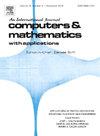Efficient coupled lattice Boltzmann and Discrete Element Method simulations of small particles in complex geometries
IF 2.9
2区 数学
Q1 MATHEMATICS, APPLIED
引用次数: 0
Abstract
Many interesting particulate flow problems can only be studied using efficient numerical methods. We present a method based on a lattice Boltzmann fluid coupled to unresolved particles that interact with each other via the Discrete Element Method. Our method improves upon existing numerical schemes through the addition of a novel subcycling algorithm that guarantees momentum conservation during each DEM substep. The intended application is studying transport of solid particles in physiologic processes, although the method is generally applicable. We present in detail the development and (parallel) implementation of the model and show how intricacies of the coupling scheme must be considered to avoid unphysical behavior and instabilities. The scalability of the code is tested on two modern supercomputers. We demonstrate the method's applicability to biomedical applications by simulating the injection and distribution of particles in an idealized liver vasculature.

复杂几何形状中的小颗粒的高效耦合晶格玻尔兹曼和离散元素法模拟
许多有趣的粒子流问题只能通过高效的数值方法进行研究。我们提出了一种基于晶格玻尔兹曼流体的方法,该流体与未解决的颗粒通过离散元素法相互作用。我们的方法改进了现有的数值方案,增加了新颖的子循环算法,保证了每个 DEM 子步骤中的动量守恒。该方法的预期应用是研究生理过程中固体颗粒的传输,尽管该方法普遍适用。我们详细介绍了该模型的开发和(并行)实施,并展示了必须如何考虑耦合方案的复杂性,以避免非物理行为和不稳定性。代码的可扩展性在两台现代超级计算机上进行了测试。我们通过模拟粒子在理想化肝脏血管中的注入和分布,展示了该方法在生物医学应用中的适用性。
本文章由计算机程序翻译,如有差异,请以英文原文为准。
求助全文
约1分钟内获得全文
求助全文
来源期刊

Computers & Mathematics with Applications
工程技术-计算机:跨学科应用
CiteScore
5.10
自引率
10.30%
发文量
396
审稿时长
9.9 weeks
期刊介绍:
Computers & Mathematics with Applications provides a medium of exchange for those engaged in fields contributing to building successful simulations for science and engineering using Partial Differential Equations (PDEs).
 求助内容:
求助内容: 应助结果提醒方式:
应助结果提醒方式:


